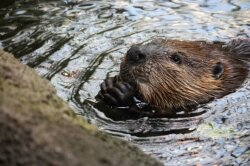American Wildways: Connecting wildlife and helping ourselves
By Amy Mathews Amos
Last year, conservation athlete John Davis left his job and spent 10 months covering 7,600 miles on an epic journey. Unlike Jack Kerouac, the 47-year old Davis traveled not by car or bus, but by kayak, bicycle, and afoot on what could be called the ultimate “un-road” trip, as he sought the wildest routes possible connecting Florida’s Key Largo with Canada’s Gaspe Peninsula.
It wasn’t the personal challenge that spurred him on. Rather, it was the desire to inform Americans that our remaining wildlands must be connected by something other than roads if we ever hope to protect the nation’s wildlife.
Davis and his conservation colleagues call their vision the Eastern Wildway– an ecologically functional, unbroken chain of East Coast wildlife habitat linking green jewels like the Florida Everglades, Great Smoky Mountains, and Adirondack Mountains with dozens of other refuges.
Out West, the Wildlands Network and other groups are pursuing a like-minded vision: working with Rocky Mountain landowners to create the Western Wildway and hoping to protect a Pacific Wildway on the West Coast and a Boreal Wildway in northern forests.
There are good scientific reasons for linking wildlands to wildlands. Roads, cities, and suburbs isolate wildlife populations, preventing them from migrating or mating. For animals needing large territories, like grizzly bears or the Florida panther, such isolation can be a death sentence.
Conservation biologists have long known that wildlife populations cut off from each other eventually dwindle and die, no matter how well managed. Studies of remote, oceanic islands show why: small populations are vulnerable to catastrophes such as disease or drought, and their separation means that numbers and gene pools are not replenished after a population crash.
Isolated habitat in national parks and other preserves works much the same way. Unless we connect wildlands, extinctions become inevitable. Impending climate change– with its dramatic geographical shifts in food supply, temperature, and precipitation– makes the linking of fragmented habitats even more urgent.
Despite his best efforts, Davis couldn’t avoid roads on his trek. His close calls with fast cars and powerful trucks gave him a new appreciation for the challenges that wildlife encounter: “I face[d] that danger by choice,” Davis said. “Animals are forced to.”
Fortunately, strategically placed wildlife corridors across major roadways are already helping. Wildlife underpasses and overpasses are aiding migrating species as varied as salamanders in Massachusetts, mountain goats in Montana, and tortoises in the Mojave Desert.
But connecting parklands isn’t enough. Davis and other conservationists see a critical role for private landowners and outdoor recreationists– hikers, hunters, anglers, mountain bikers, birders, and others– in creating American Wildways.
Even in the West with its vast public lands, conservationists increasingly are turning to private landowners to fill habitat gaps. “We’ve been hypnotized in the West by the abundance of public land,” says Dr. Michael Soulé, Professor Emeritus at the University of California at Santa Cruz and one of the founders of the Wildlands Network. Unfortunately much federal land is dedicated to gas wells, mining and timber harvest, not wildlife habitat.
That’s why Western conservationists are working closely with ranchers to create ecological and recreational corridors, offering lessons for budding East Coast efforts. The High Lonesome Ranch in Colorado, for example, is pioneering new techniques for restoring and conserving habitat on working ranches. “I think there’s starting to be a shift in attitude,” says Soulé. “There’s more opportunity on private land… which is kind of nice because it brings conservation back to being people-oriented.”
Davis agrees, and emphasizes the importance of people getting outdoors– away from electronic distractions and onto greenways and blueways. “This trek convinced me… that we really need to get people out there to value these places,” he says. People “don’t tend to be passionate about things unless we’ve had first-hand experience.”
Davis admits to questioning his own sanity at times on his trek, dodging trucks on a South Carolina highway or fighting off hypothermia in Maine. But he was on a mission to save our nation’s wildlife, and besides, he had a hell of a lot of fun. So much fun that he’s already planning his next trek, this time in the Rocky Mountain West.
~
Amy Mathews Amos is an independent environmental consultant and writer. This essay was distributed by the Blue Ridge Press.

2 comments
The land consumed by gas wells and mining is less than1% of the total acreage. The forests are managed well with immense resytictions and the reforestation provides habitat and food for many smaller animals that the forest does not.
I am glad for his efforts and there are good reasons to continue but villifying much needed sources of domestic energy and resources may bring some attention but at the end of the day it simply causes the energy people to spend more on lobbying and less on projects like his.
Hopefully we'll be able to find new ways to conserve these wildlands soon. Spending as much time in the Florida Everglades as I do makes me wonder how anyone could even think of destroying such beautiful lands...